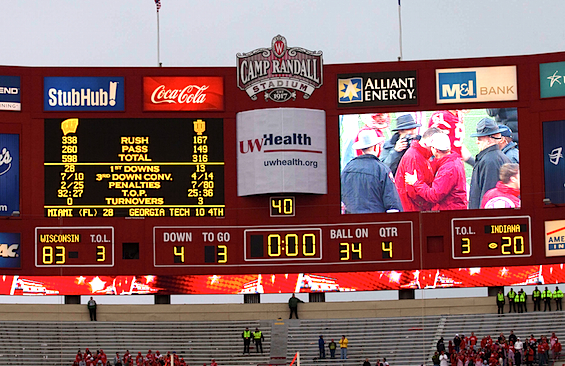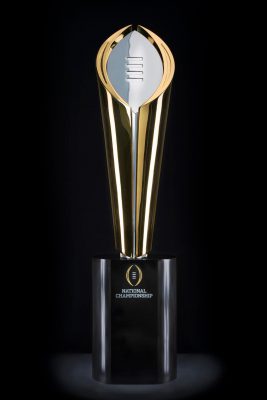The Problem
Last month, I speculated that Oregon’s future schedules may not be sufficiently strong to qualify for the College Football Playoff. In the event of a one-loss Pac-12 record, a weak nonconference schedule could have the Ducks on the outside looking in come a future January.
This is precisely the situation facing Wisconsin. Were the Badgers to lose one of their remaining two regular season games, or even a conference championship game, they will likely be rated lower than other one-loss teams: Alabama and/or Georgia, Clemson and/or Miami and Oklahoma. They would also drop below a two-loss Ohio State team if the Buckeyes win the Big-10.

A terribly weak schedule could cost Wisconsin a Playoff birth
Combined with a very weak Big-10 slate, nonconference foes Utah State, Florida Atlantic and BYU helped relegate the Badgers to 42nd in the most recent schedule strength rankings.
This is far, far below the rankings of the other playoff contenders. Bottom line, the College Football Playoff committee is probably not going to reward a one-loss team — even a conference champion — with a playoff spot unless it has a quality nonconference win. Parenthetically, Washington would be facing the same dilemma had it finished with only a single loss. Its cupcake-laden nonconference slate of Rutgers, Montana and Fresno State contributed to a lower rank than even Wisconsin’s.
For Oregon, the solution is not to go undefeated in the Pac-12, although this would likely guarantee a playoff spot irrespective of its nonconference slate. During the last 25 years, there have only been five teams that have survived the conference gauntlet unscathed. One of those, USC in 2004-05, later vacated wins due to NCAA violations. So, the odds of emerging undefeated in-league are exceedingly low.
Absorbing an early nonconference loss to a ranked opponent is obviously a risk. But the College Football Playoff selection committee has demonstrated that a quality win carries more weight than a tough loss.
Assuming then, that any Pac-12 champion will likely have a conference loss, a nonconference slate consisting of Bowling Green, Portland State and San Jose State (UO’s 2018 lineup) isn’t going to cut it. It is unlikely that this will matter next season, but as the Ducks ascend, scheduling only weak opponents (intentionally or not) is a big gamble.
Back in 2012, Wisconsin’s athletic director probably thought that a victory over BYU would be perceived as a quality win. Not so, as it turns out.
The safest course of action is to schedule at least one formidable nonconference team. As noted in the previous article, the Ducks’ 2014 victory over highly-ranked Michigan State compensated for a blowout loss at Arizona. UO was fortunate to have faced Michigan State instead of, say, Illinois. Would the Ducks still have made the playoff? Maybe. Maybe not.
The difficulty in deciding who to schedule is exacerbated by the extremely long time lag between signing a contract and actually playing the game(s). That interval typically ranges from five to 12 years. Just look at the last five years: Penn State and Washington went from outhouse to penthouse. Florida State is headed in the opposite direction and Baylor has already hit rock bottom.
Texas A&M, Auburn, Notre Dame, Michigan State and Iowa have been all over the map. And Oregon went from national runner-up to bowl ineligible in a heartbeat. Which Power-5 teams will be strong enough in 2025 (UO’s next opening) to enhance the Ducks’ playoff chances? Who knows!
A Possible Solution
Let’s take a page from the Big Ten-ACC Challenge. This annual basketball event pairs up teams that are projected to be of similar strength. In June, the 2017 matchups were established: Notre Dame at Michigan State, Louisville at Purdue, Wisconsin at Virginia, Florida State at Rutgers and so forth. The goal is to schedule games that will be competitive. After years of ACC domination, the series and the games themselves have been close for eight consecutive years.
Now, extrapolating from a two-conference, annual basketball series to football takes a giant leap. So, here it goes: Oregon’s next non-conference football openings are in 2025 and 2026. Checking FBSchedules.com, 30 Power Five schools have openings for a Power Five opponent during the same two seasons. Either the school has no Power Five opponent or the school has a history of playing two Power Five nonconference games and only one is set.
Thirteen schools require or prefer a home game in 2025; 10 (including Oregon) require or prefer a home game in 2026. The remaining seven evinced no obvious preference and could accommodate a home (or away) game in either season. Because the ACC and SEC play only eight conference games, their members have more nonconference openings and dominate the following list of candidates:
2025 @ Home (2026 Away): Miami, Clemson, Florida State, Wake Forest, Baylor, Kansas, Texas, Texas Tech, Ohio State, Cal, USC, Missouri, Stanford.
2026 @ Home (2025 Away): Oregon, Duke, Louisville, Oklahoma State, West Virginia, Auburn, Florida, Kentucky, South Carolina, Tennessee.
2025 or 2026 @ Home: NC State, Syracuse, Virginia, Oregon State, Utah, Alabama, Ole Miss.

Finding a good matchup eight years from now
Every school on the list would be invited to join a consortium to create competitive matchups in 2025 and 2026. The exact pairings would not occur until January of those years. Pairings would be based on some established performance metric, say, S&P+, so that teams that were comparable in 2024 would play one another in 2025 — and possibly in 2026 as well (For information on S&P+, see footballoutsiders.com).
Every participating school would play one home game and one away game, according to the scheduling preferences shown above. The opponent could be the same for both years (similar to a conventional home and home arrangement), or the 2026 opponent could be determined by the S&P+ rating from 2025. But either way, the chances of drawing comparable opponent are far better than they are scheduling 5-12 years in advance.
To illustrate, suppose 18 of the 30 qualifying schools opt to join the consortium and sign a contract that guarantees each team a home game in its year of preference. Its opponent(s) will come from the list of schools with the complementary preference year.
I’ve randomly selected 17 schools plus UO and divided them into 2025 and 2026 (home game) preference groups. I used the no preference volunteers to equalize the number of teams on the two lists. There will be nine consortium nonconference games played in each of the two seasons.
Just for fun, I used this week’s S&P+ values to rank the nine schools on each list. So, number one on the 2025 (home) list plays number one on the 2026 list and so forth. Of course, the current values are irrelevant, but I’ve used them just to show what the matchups would look like in 2018.

A National Championship Trophy would look good in the Cas Center
Ohio State vs. Alabama
Miami vs. Auburn
Louisville vs. Oklahoma State
Missouri vs. West Virginia
Wake Forest vs. Oregon
Utah vs. South Carolina
Texas vs. Virginia
Cal vs. Duke
Baylor vs. Oregon State
Caveats and Discussion
There are, of course, no guarantees that all pairings will be optimal. But, predictions made one season ahead will certainly be better than those made years in advance. There are already too many mismatches in college football without adding to them by scheduling a decade ahead.
Moreover, a team that needs a quality nonconference opponent to enhance its resume will have a much better chance of acquiring one under the proposed arrangement. The Wisconsin dilemma never arises. And, the weaker Power Five programs will face one another, something that many try to orchestrate anyway. Essentially, each participating team is reserving a slot that is likely to result in a competitive game. By 2025, the sample matchups will look altogether different. If the Ducks project to be a playoff calibre team, then they would be paired with a contender from the complementary (2025) list.
It is worth noting that provisions will need to be made to severely penalize or prevent a team from breaking its contract with the consortium. Second, matchups based purely on a performance index will need to be adjusted to avoid conference members from playing one another (unless they will skip each other during conference play). Undoubtedly, there are other contingencies that will need to be addressed in hammering out the details, including the minimum number of teams required.
Do not make the mistake of thinking that an expanded Playoff by 2025 will reduce the importance of schedule strength. Once the Power Five conference champions and a group-of-five representative are selected for, say, an eight-team playoff, then the remaining two at-large births are sure to be heavily influenced by ones entire resume. Imagine how difficult it will be to differentiate excellent conference runners-up (and independents). Schedule strength will likely play an even greater role in an expanded College Football Playoff, at least among at-large candidates.
Finally, if this proposal were adopted and ultimately deemed a success, then it would be many years before it could be institutionalized on a more permanent and widespread basis. But then, athletic directors are used to looking far ahead, which is a big part of the problem.
Mark Weinrott
Eugene, Oregon
Top photo credit: deAcademic.com
Related Articles:
Oregon Enters Playoffs Better Off Than Last Year
Will The Coaching Carousel Kill Oregon's CFP Chances?
The Playoff Formula Hasn't Changed
Oregon Aims to Bury Dawgs, Punch Playoff Ticket in Rivalry Clash
Huskies Are the New Beavers, Stay In Your Lane Kiffin, and the Civil Apple Cup War
Oregon Football: The X-Factor Vs. Washington
A retired Psychologist recently relocated to Eugene, Mark Weinrott adopted the Ducks in 1974. He played soccer in college, coached soccer at South Eugene High School, served as a statistical consultant to four National Hockey League teams and officiated boys/men’s lacrosse for seven years. He is an avid Oregon football and basketball fan, season ticket holder and donor.

